Banner photo shows interior of W. E. Saults’s barber shop, from Hespeler, Canada: A souvernir of the Factory Town, 1901.
In the 1830s, there were just seven barbers officially listed in the city’s first record: Jarrad Banks and William Hickman were on Front St, W. R. Edwoods on Market Square, Charles Smith (who also cleaned clothes) was on Church, M. Kelley on Yonge, and George Wilkinson and Newton Cary on King St. Of these seven, at least four were African Americans who had most likely come to the city to flee slavery in the U.S. As the years went on, and the situation across the border became more dangerous with the Fugitive Slave Act of 1850, the number of African American barbers would triple. Included in their number was a man with the marvellous name of Junius Slaughter. Slaughter’s barber shop was on Front St. and he was remembered by W. H. Pearson as being “about four feet in height and quite a notable character.” There was also Thomas F. Cary who married the great activist/journalist Mary Ann Shadd. He was one of four Cary brothers who each had their own barber shop in the 1850s – Newton, George and John J. being the others.
While African Americans would continue to operate the majority of Toronto barber shops throughout the 1850s and early 1860s, a new era of hair care was beginning. Barbers now began to advertise their services and new terms were being used. Where before a barber was a barber was a barber, now there were a slew of “hair dressers” and “hair cutters.” There was also this guy:
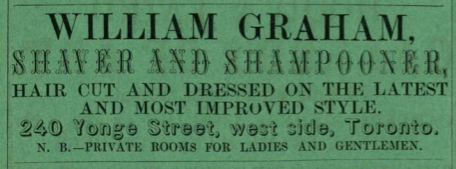
Others were apparently so tonsorial-ly talented that they were Professors of the trade:
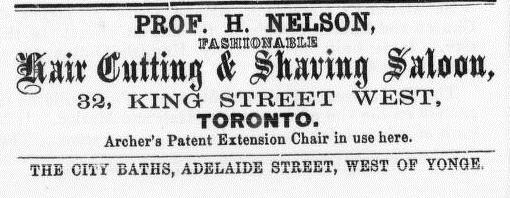
Perhaps about now you’re wondering what delightful hair saloons were available if you were a lady of the day. Well, it was a short list, sister. For several years there was only the Misses Bates’ at 31 King West.
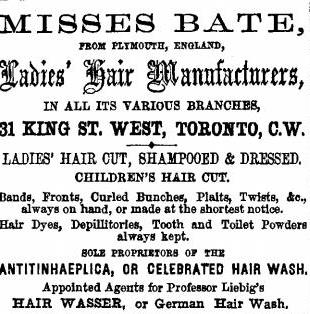
But believe it or not, this was kinda racy stuff. “Respectable” women of the era did not go “out” to get their hair done. What hair dressing they did was commonly done at home – by a maid if you were flush, or yourself if you weren’t. So really the only aspect of hair dressing aimed at women was the purchasing of products to be used in their own creations. Because having lots of hair was all the rage, most of these had to do with supplementing your own. And man, did they use everything imaginable.
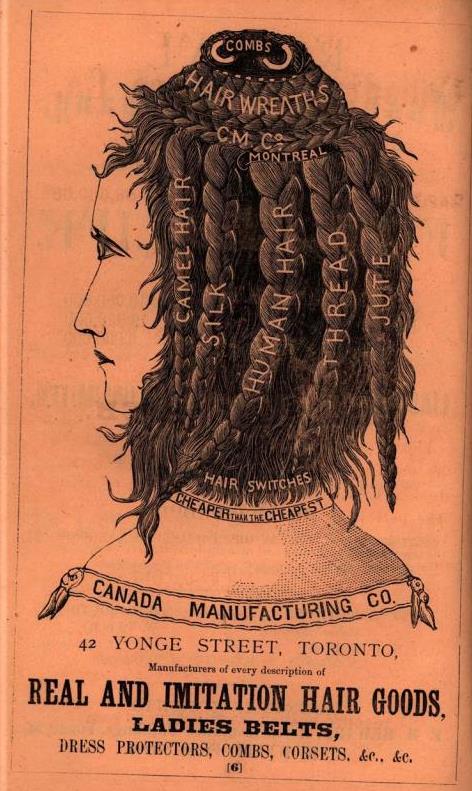
Despite what that horrid illustration would have you believe, the “Medusa mop” was not a real fad. No, the popular style of the day was the chignon. Now I’m going to get personal here for a moment and tell you that when I wish to wear my hair in one, I just pull it back and pin it. But apparently there used to be a lot more to it than that because there existed such things as the Toronto Chignon Factory and the Dominion Chignon Manufacturing Co. I’m sure a lot of intricate hair wizardry was done within these companies, but all I can picture is a room of women forming balls of hair at long tables.
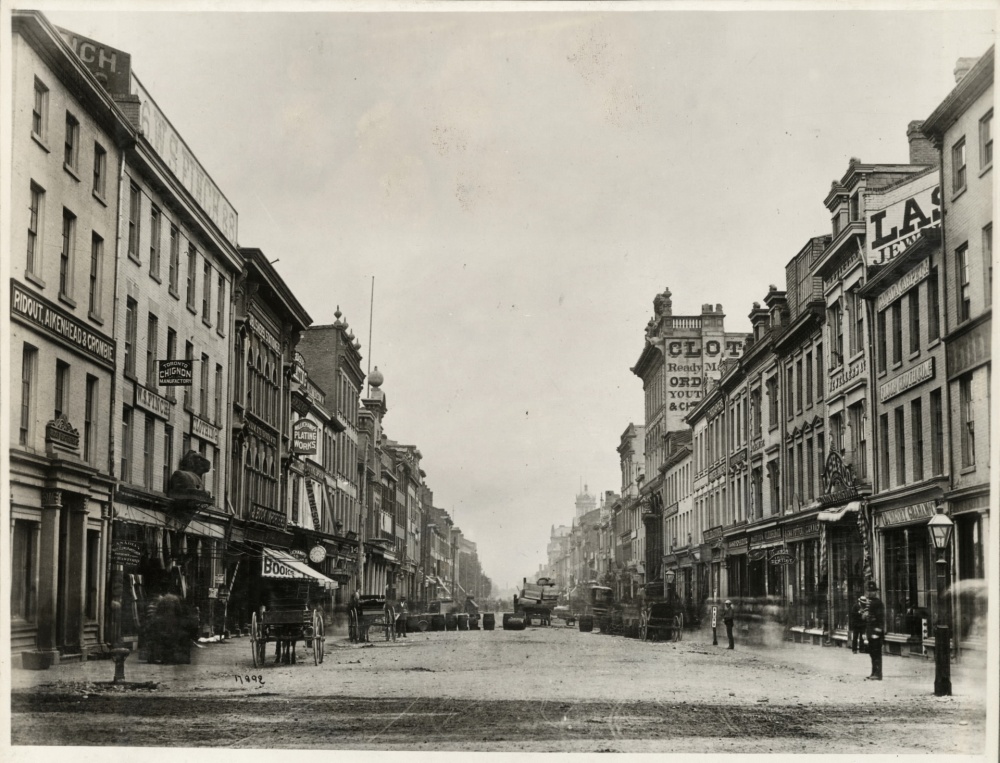
And so the hair industry in Toronto continued through the 1860s and 1870s, with barbers and hair dressers and hair manufacturers drifting into business and out of it, with no clear centre or star to elevate and brand it as a major concern. But that all changed with the 1880 arrival of a German couple named Dorenwend.
When they first arrived, Hildebert Dorenwend opened a barber shop on Richmond, while Anna set up her own shop and “hair works” on King E. Within a year though they decided to join forces at 105 Yonge St. and re-branded themselves as the Paris Hair Works. Their empire had begun.
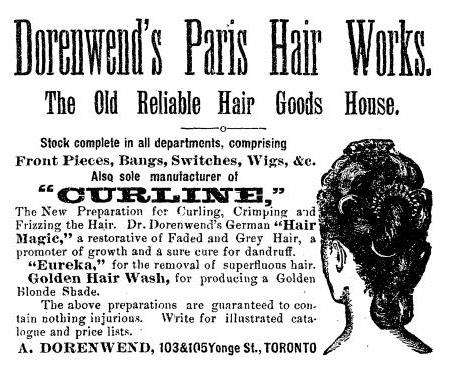
The Dorenwends did it all. They barbered, they shaved, dressed, rinsed, dyed, made chignons, wigs and toupees, cured dandruff and removed the kind of hair you didn’t want. And to assure you that their methods were indeed the best and most scientific, Hildebert gave himself a professorship, guaranteed to remove any doubt. But if you didn’t care a jot about the methods and instead wanted reassurance that you were getting the most fashionable, up-to-the minute styling – well, it was the Paris Hair Works. What more could a body want?

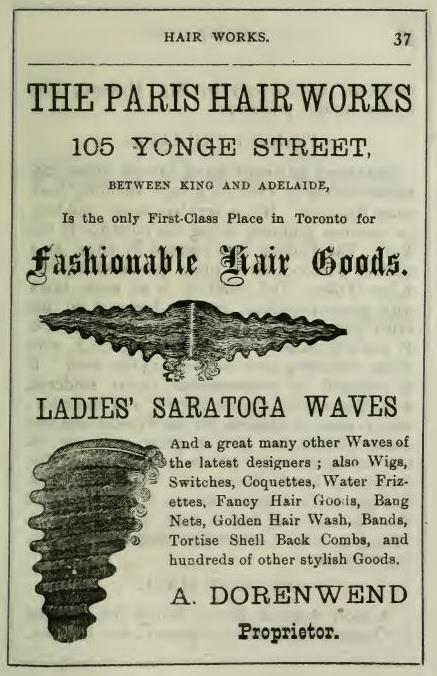
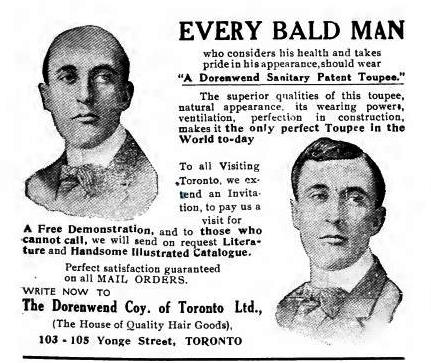
There’s no record of her death that I can find, but it appears that Anna Dorenwend likely died sometime in 1885-6. There’s actually no record even that Anna and Hildebert were married (they could’ve been brother and sister), but I imagine they were because it was with her disappearance from the city’s records that Hildebert married a girl named Bella Robinson who worked in the shop as a clerk. And also boarded in his residence, I might add.
In any case, the Paris Hair Works had grown so much by 1888 that Hildebert took on the neighbouring space at 103 Yonge. His staff blossomed to include a perfumer, a porter and a foreman in addition to a number of barbers and hairdressers. Also on his staff, and boarding at his home, was his son Christian H. Dorenwend. Christian started in the shop as a clerk and soon became an assistant, then book keeper and finally manager. He was obviously being groomed to take on a large part of the Dorenwend business, but his heart was not in hair – he wanted to invent things.
In 1891, Christian Dorenwend left the hair works and began his own business selling an invention of his own. Hildebert must’ve been pretty supportive of the venture because he let him use the 103 Yonge storefront for the company. It was now the Dorenwend Electric Belt and Attachment Co.
Let’s take a look at the contraption:

If you can believe it, you were supposed to put that thing around you and zap your organs into good health. Hard to imagine that anyone looked at that and thought “Oh boy, yes please – electrify my bowels.” … Actually, when I think about it, people are still selling dubious things like this. When I was a kid, my mother had one of those Dr. Ho’s Muscle Therapy things that was supposed to soothe sore muscles with jolts of electricity (I think). I don’t remember it being particularly effective, but then my sister and I only used it to try to spasm the crap out of each other.
But I digress…
For a couple of years, Christian and Hildebert enjoyed plying their respective trades as neighbours. But then in 1893, Christian moved off of Yonge and set up shop at 227 Spadina. Yonge being a much better known shopping district, this move appears to have signalled a step down for Christian. With 103 vacated, Hildebert once again took up the space.
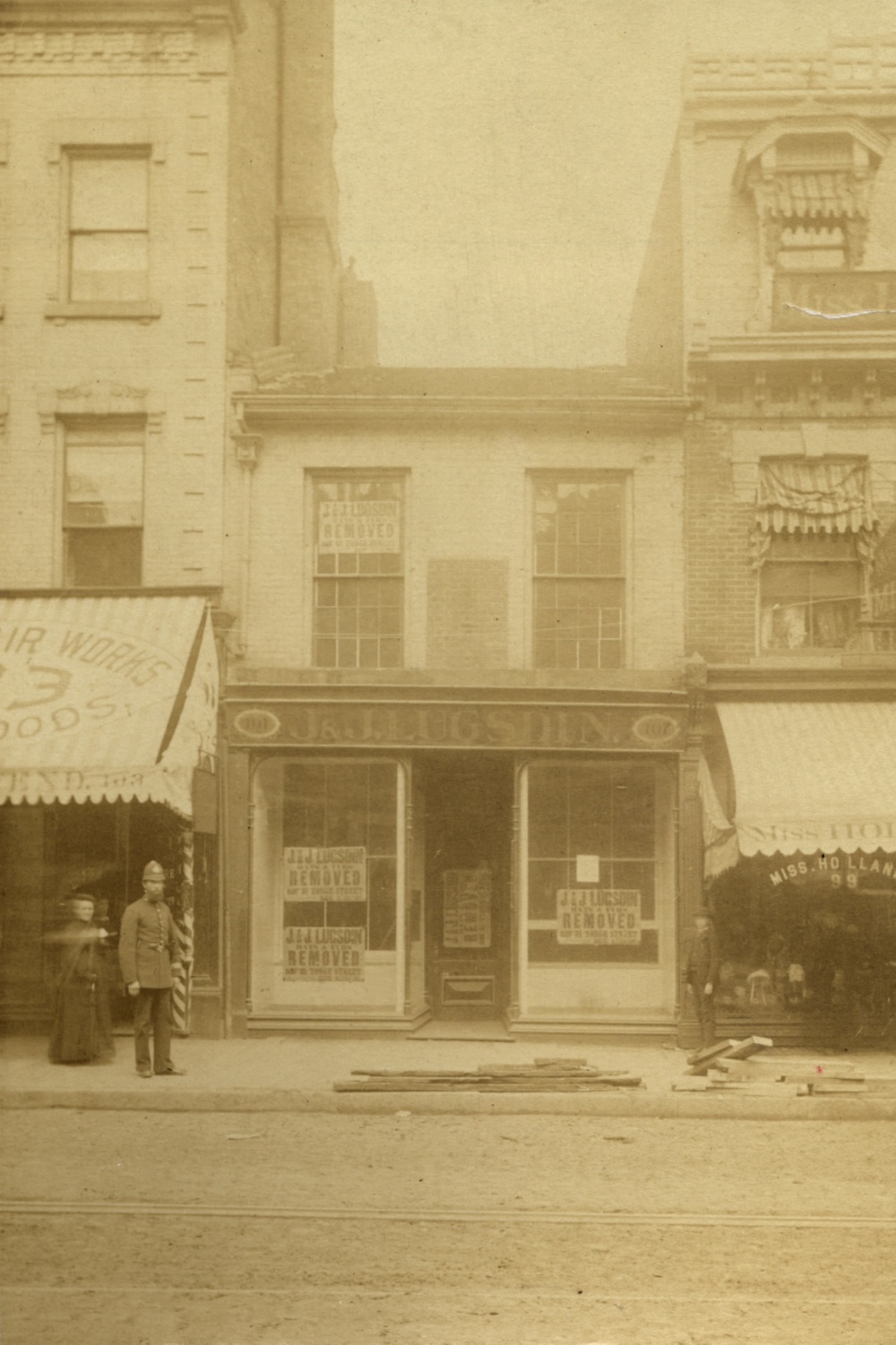
Hildebert’s business continued to grow and with it his staff. In fact, he had so many young ladies working for him at the turn of the century that you can get a pretty good read of popular girls’ names of the era. There was an Effie, Berna, Louise, Emma, Fanny, Iola, Edith, Bessie, Flora, Mamie, Ida, Alma, Olive, Jean, Mary, Maud, Helen, Nellie, Bella, Vida, Gertie, Grace and three Lilys. Oh, and my absolute favourite, a Miss Birdie Beauchamp.
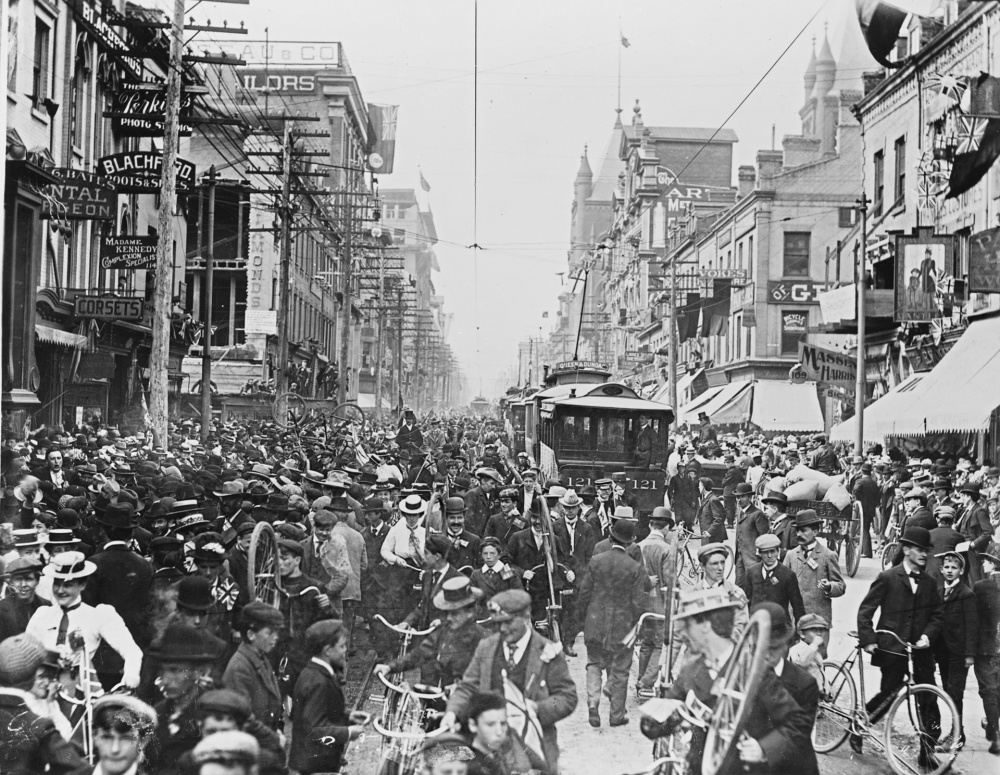
Sadly, business over on Spadina was not as good for Christian Dorenwend. Within a year of taking the space there, he was on the move again. And he would keep on moving, almost once a year. His business seems to have gotten smaller and smaller and soon even his living circumstances seemed pinched, as he was listed as a boarder at 773 Yonge. The final listing for his once up-and-coming Dorenwend Electric Belt and Truss Company was a small office at 389 1/2 Yonge – one of many businesses in a building that also housed the Idler Bicycle Club, Royal School of Dance, the Shaw Business College and the offices of two dentists named Ziegler and Zinkan. In 1909, he was gone – either dead or in pursuit of greener pastures – and left no further mark on the city.
As Christian Dorenwend’s star fell, Hildebert’s rose. The Paris Hair Works, now known as the Dorenwend Company of Toronto, had opened a successful branch in Ottawa. Hildebert and his family had moved out of the rooms above the shop and were now living in a grand home on Jarvis St. and also owned an apartment house on George. Most telling of their standing in the city, they were listed in the Toronto Society Blue Book. It was all a remarkable success for a barber – a trade that had previously put food in bellies and clothes on backs, but had never brought fame and fortune before.
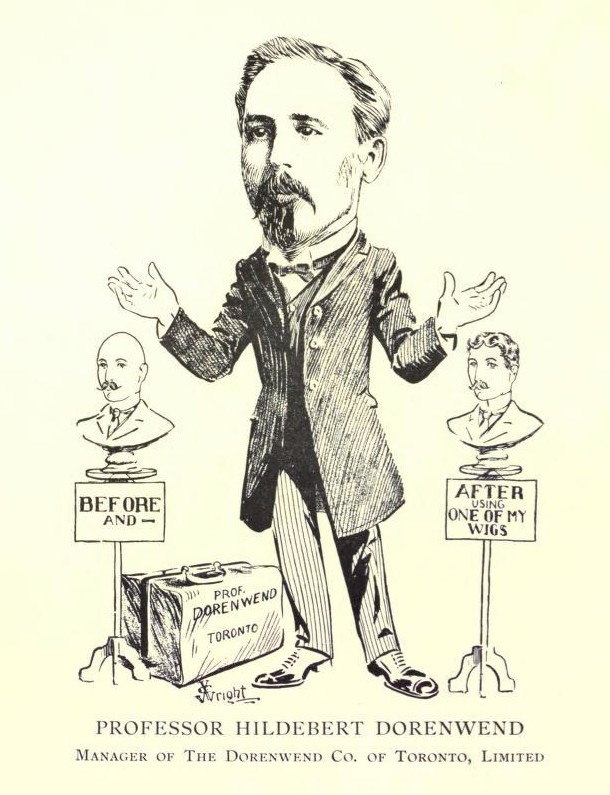
But of course, every man must meet his end. Hildebert Dorenwend died in 1920 and shortly afterwards his wife and children moved to California. They buried him at Forest Lawn cemetery with a simple marker that shares the briefest of details. It tells you only that he was born in Germany in 1847 and died in Toronto. He is the only Dorenwend you will find there. Where Anna of the early Paris Hair Works is, or Christian of the Electric Belt and Truss, I can’t tell you. But I can tell you that the Dorenwend Company was soon sold and folded into another company. For having loomed so large, it was forgotten quite quickly and today the name Dorenwend is as foreign as the idea of wearing a camel hair wig.

good one!
Sent from my iPhone
>
LikeLiked by 1 person
What a magnificently detailed read on the history of hairdressing in Toronto! (I feel like that looks kind of sarcastic, but I’m being sincere. Old hairstyles are really interesting. I tried to write a final paper on wigs once for an 18th century history class, but I couldn’t find enough (any) secondary sources.) Um, obviously I would go to the professor, if he would deign to cut a lady’s hair. Failing that, I would buy the hair bat and wear it in such a way that it would look like a bat. It’d match my new tattoo.
LikeLiked by 1 person
Aw, thank you! I’m so happy you liked it! There were so many weird characters involved in hair here (and so many bizarre ads!) it was hard to limit myself to talking about only a few. Ha! I LOVE bats so I would totally applaud your bat-hair – and your new tattoo!
LikeLiked by 1 person
Me too (obviously)! Is it weird if I link to a picture of my ribs on your blog? Hell with it, I’m doing it anyway, since I don’t get to show off Bert the Bat enough. What with not really really having many opportunities to remove ones’ shirt in public and all. https://www.instagram.com/p/_hMtFXgD7Z/?taken-by=ladysealegs
LikeLike
Ha, I was going to ask if you could wrangle me a photo! Bert the Bat is adorable – so beautifully done! I’m honoured to have him here 🙂
LikeLiked by 1 person
Thank you! It’s the first new tattoo I’ve gotten in a decade, so he was kind of a big deal for me. 🙂
LikeLike
I bet! I haven’t had a new one for some time either. I’m always tempted, especially when I see nice work like yours!
LikeLiked by 1 person
Is there anyone giving a more complete underground history of Toronto than you? The Chamber of Commerce oughta be paying you for this. Amazing history. When I come to Toronto, I’m enlisting you as my guide.
Also, nice pun on the hair manufacturer who “loomed” large. I applaud that.
LikeLiked by 1 person
Ha! I’m so glad you like my little histories. I have a (probably too intense) love of the every man/woman – I find them way more fascinating and instructive than the people lauded formally around here. And you bet your ass – you come to Toronto, I will happily show you around. I promise I’m not always so punny. Ok, that’s a lie.
LikeLike
Actually, I don’t know about M. Kelley, but in early city directory, 6 out of 7 were black barbers.
LikeLike
Thank you – much appreciated!
LikeLike
I am so glad your tweet directed me here today. And, if you think I just wasted 20 minutes using the googler to try to find images of all the different styles of bangs that are listed in these adverts … ok, so maybe it was 25 minutes. I always just thought bangs were bangs. You teach me something new with every post.
A wonderful post!
LikeLiked by 1 person
Thank you! I’m really glad you enjoyed it – and I’m so glad that we’re pals now on the Twitter (as my mom would say) – makes it a much more fun place 🙂
LikeLike
Great stuff! Christian was Hildebert’s son and he was a key witness in the murder trial of Clara Ford, which brought me here. I’m going to cite this post because it brought me much laughter!
LikeLiked by 1 person
Such a treat to get your note! I’m so happy to hear you enjoyed it.
And of course – Christian was his son! Ack! Thank you for that. An edit is due.
And, ah yes – the Clara Ford trial. What a tale that is.
LikeLike
Recently read this brief article while investigating the Professors’ appearance in Guelph in 1887. Annie was married to H. when they arrived. The 1881 census lists them as both being age 32 and having two children, Hildebert (13) and Florinda (8).
LikeLike
Thank you for sharing!
LikeLike